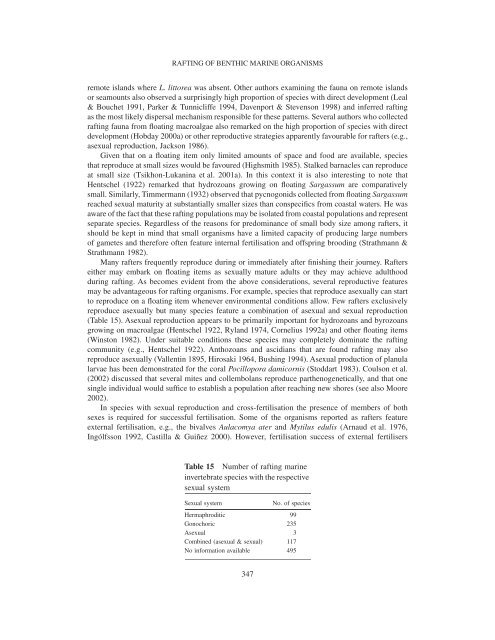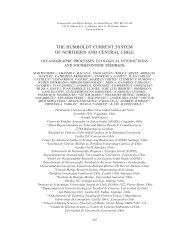The ecology of rafting in the marine environment - Bedim
The ecology of rafting in the marine environment - Bedim
The ecology of rafting in the marine environment - Bedim
You also want an ePaper? Increase the reach of your titles
YUMPU automatically turns print PDFs into web optimized ePapers that Google loves.
RAFTING OF BENTHIC MARINE ORGANISMS<br />
remote islands where L. littorea was absent. O<strong>the</strong>r authors exam<strong>in</strong><strong>in</strong>g <strong>the</strong> fauna on remote islands<br />
or seamounts also observed a surpris<strong>in</strong>gly high proportion <strong>of</strong> species with direct development (Leal<br />
& Bouchet 1991, Parker & Tunnicliffe 1994, Davenport & Stevenson 1998) and <strong>in</strong>ferred <strong>raft<strong>in</strong>g</strong><br />
as <strong>the</strong> most likely dispersal mechanism responsible for <strong>the</strong>se patterns. Several authors who collected<br />
<strong>raft<strong>in</strong>g</strong> fauna from float<strong>in</strong>g macroalgae also remarked on <strong>the</strong> high proportion <strong>of</strong> species with direct<br />
development (Hobday 2000a) or o<strong>the</strong>r reproductive strategies apparently favourable for rafters (e.g.,<br />
asexual reproduction, Jackson 1986).<br />
Given that on a float<strong>in</strong>g item only limited amounts <strong>of</strong> space and food are available, species<br />
that reproduce at small sizes would be favoured (Highsmith 1985). Stalked barnacles can reproduce<br />
at small size (Tsikhon-Lukan<strong>in</strong>a et al. 2001a). In this context it is also <strong>in</strong>terest<strong>in</strong>g to note that<br />
Hentschel (1922) remarked that hydrozoans grow<strong>in</strong>g on float<strong>in</strong>g Sargassum are comparatively<br />
small. Similarly, Timmermann (1932) observed that pycnogonids collected from float<strong>in</strong>g Sargassum<br />
reached sexual maturity at substantially smaller sizes than conspecifics from coastal waters. He was<br />
aware <strong>of</strong> <strong>the</strong> fact that <strong>the</strong>se <strong>raft<strong>in</strong>g</strong> populations may be isolated from coastal populations and represent<br />
separate species. Regardless <strong>of</strong> <strong>the</strong> reasons for predom<strong>in</strong>ance <strong>of</strong> small body size among rafters, it<br />
should be kept <strong>in</strong> m<strong>in</strong>d that small organisms have a limited capacity <strong>of</strong> produc<strong>in</strong>g large numbers<br />
<strong>of</strong> gametes and <strong>the</strong>refore <strong>of</strong>ten feature <strong>in</strong>ternal fertilisation and <strong>of</strong>fspr<strong>in</strong>g brood<strong>in</strong>g (Strathmann &<br />
Strathmann 1982).<br />
Many rafters frequently reproduce dur<strong>in</strong>g or immediately after f<strong>in</strong>ish<strong>in</strong>g <strong>the</strong>ir journey. Rafters<br />
ei<strong>the</strong>r may embark on float<strong>in</strong>g items as sexually mature adults or <strong>the</strong>y may achieve adulthood<br />
dur<strong>in</strong>g <strong>raft<strong>in</strong>g</strong>. As becomes evident from <strong>the</strong> above considerations, several reproductive features<br />
may be advantageous for <strong>raft<strong>in</strong>g</strong> organisms. For example, species that reproduce asexually can start<br />
to reproduce on a float<strong>in</strong>g item whenever <strong>environment</strong>al conditions allow. Few rafters exclusively<br />
reproduce asexually but many species feature a comb<strong>in</strong>ation <strong>of</strong> asexual and sexual reproduction<br />
(Table 15). Asexual reproduction appears to be primarily important for hydrozoans and byrozoans<br />
grow<strong>in</strong>g on macroalgae (Hentschel 1922, Ryland 1974, Cornelius 1992a) and o<strong>the</strong>r float<strong>in</strong>g items<br />
(W<strong>in</strong>ston 1982). Under suitable conditions <strong>the</strong>se species may completely dom<strong>in</strong>ate <strong>the</strong> <strong>raft<strong>in</strong>g</strong><br />
community (e.g., Hentschel 1922). Anthozoans and ascidians that are found <strong>raft<strong>in</strong>g</strong> may also<br />
reproduce asexually (Vallent<strong>in</strong> 1895, Hirosaki 1964, Bush<strong>in</strong>g 1994). Asexual production <strong>of</strong> planula<br />
larvae has been demonstrated for <strong>the</strong> coral Pocillopora damicornis (Stoddart 1983). Coulson et al.<br />
(2002) discussed that several mites and collembolans reproduce par<strong>the</strong>nogenetically, and that one<br />
s<strong>in</strong>gle <strong>in</strong>dividual would suffice to establish a population after reach<strong>in</strong>g new shores (see also Moore<br />
2002).<br />
In species with sexual reproduction and cross-fertilisation <strong>the</strong> presence <strong>of</strong> members <strong>of</strong> both<br />
sexes is required for successful fertilisation. Some <strong>of</strong> <strong>the</strong> organisms reported as rafters feature<br />
external fertilisation, e.g., <strong>the</strong> bivalves Aulacomya ater and Mytilus edulis (Arnaud et al. 1976,<br />
Ingólfsson 1992, Castilla & Guiñez 2000). However, fertilisation success <strong>of</strong> external fertilisers<br />
Table 15 Number <strong>of</strong> <strong>raft<strong>in</strong>g</strong> mar<strong>in</strong>e<br />
<strong>in</strong>vertebrate species with <strong>the</strong> respective<br />
sexual system<br />
Sexual system No. <strong>of</strong> species<br />
Hermaphroditic 99<br />
Gonochoric 235<br />
Asexual 3<br />
Comb<strong>in</strong>ed (asexual & sexual) 117<br />
No <strong>in</strong>formation available 495<br />
347










